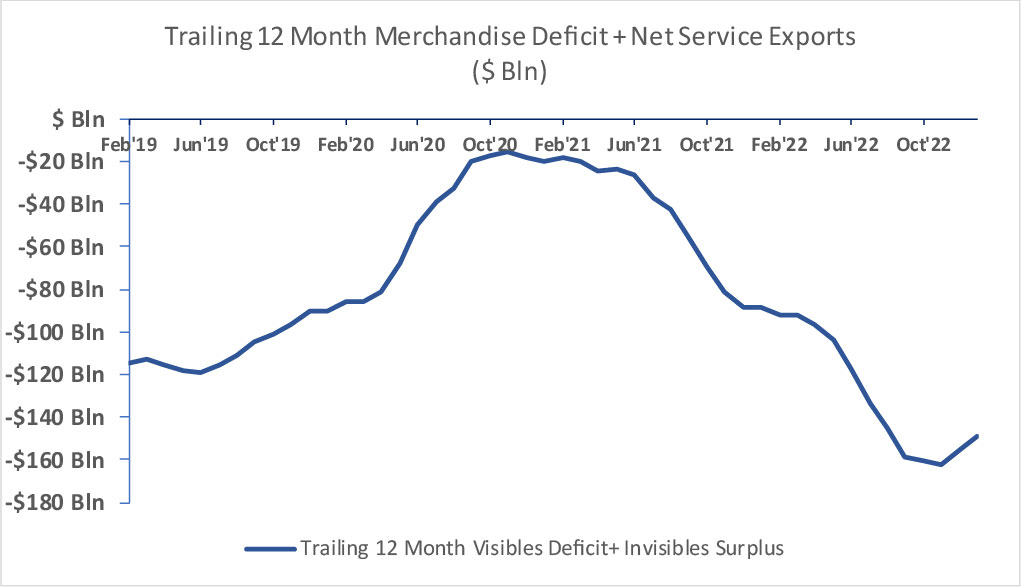
Macro and
Equity Market
Outlook
Equity Market
Outlook
GLOBAL MACRO & MARKETS – Feb 2023
Indian markets fell in February, in line with major global markets.
The Nifty Index corrected marginally by -2.0% in February, falling for
a third consecutive month. Major global indices fell over the month,
with HANG SENG leading the fall, with a -9.4% decline. The S&P500
(-2.6%) marginally corrected, while the Euro 50 (+1.8%) and the
Nikkei (0.4%) witnessed rise in February. MSCI EM index fell 6.5% while
Brazil’s BOVESPA fell by -6.5%. LME Metals Index witnessed a fall of
-7.5% over the month as the metals markets remained volatile,
owing to a firmer dollar and subdued demand from largest
consumer China. WTI and Brent Crude fell by -2.3% and -0.7% in
February. The Dollar index rose by 2.7% over the month on
increased expectations of further rate hikes by the US Fed.
Additionally, the Dollar appreciated +1.6% over the month vis-à-vis
the INR. India 10Y G-Sec rates rose by 9 bps, while the USA and
Germany’s 10Y G-Sec yields rose by 41 and 37 bps respectively,
settling at 7.4%, 3.9% and 2.6% respectively, as the aggressive global
monetary tightening cycle is expected to continue.
Domestic Macro & Markets - Feb 2023
SENSEX fell by -3.6% in February. Mid-cap and small-cap indices
were down -2.5% and -2.0%, respectively, outperforming the index.
On the sectoral front, power (-16%), oil & gas (-9%) and metals
(-10%) indices fell the most, while FMCG (+0.3%), IT (+0.2%) were the
only indices to close in green. FIIs (Foreign Institutional Investors)
continued to be net sellers in February (-$0.1bn, following -$3.7bn in
January). DIIs (Domestic Institutional Investors) continued their
buying trend from the previous month, recording positive flows
(+$2.3bn).

India's high frequency data update:
Sustained high levels of GST collections, strengthening, but
moderating core, resilient manufacturing & agricultural sector
outputs, moderating inflation and healthy credit growth augur well for
the economy.
Manufacturing PMI:
Manufacturing PMI in February’23 moderated to a 4-month low,
reaching 55.3, and remained in expansion zone (>50 points) for the
20th straight month, as output and new orders weighed in. Foreign
sales and buying levels remained elevated, above long-term
averages.
GST Collection:
Collections of INR 1.49 Tn (+12% YoY) in February’23 concluded the
twelfth consecutive month of collections over the 1.4Tn mark, with
cess collections at its highest recorded levels. Increased
compliance and strong nominal economy have been key reasons
for sustained collection levels.
Core sector production:
Core sector production growth accelerated MoM to 7.8% YoY in
January 2023, against a 4% growth in January 2022, owing to a
healthy expansion in seven of the eight component sectors. Coal,
fertilizers, and electricity rose 13.4%, 17.9% and 12% respectively.
Crude Oil was the only component to decline, with a -1.1% fall.
Industrial Production:
Factory output as measured by the IIP (Index of Industrial
Production) index growth decelerated MoM to 4.3% YoY in
December’22 vs an expansion of 4.3% YoY in November’22.
Electricity production recorded the biggest increase (10.4%),
followed by mining (9.8%) and manufacturing (2.6%).
Credit growth:
Credit growth reached 16.05% YoY as of 10th February 2023 against
YoY growth of 8.02% as observed on 11th February 2022.
Inflation:
January’23 CPI inflation accelerated to a 3-month high of 6.52%
from 5.72% in December’22, led by rising food prices- namely
cereals and spices. WPI inflation continued to drop, with the
January’23 print at a 23-month low of 4.73%, 22 bps down from
December’22s at 4.95%.
Trade Deficit:
Indian Merchandise Exports recorded a decline of -4.6% YoY to
$32.91 Bn in January’23, on account of weaker global demand, while
Imports decreased slower, by -2.4% YoY to $50.66 Bn. India’s trade
deficit narrowed YoY to $17.75 Bn from $23.76Bn in December of the
2022.
Events you may watch out for in March 2023:
India CPI Inflation data:
All eyes will be on Indian inflation data, set to be released in
mid-March, as the RBI continues its path of monetary tightening,
after hiking the repo rate by 25bps to 6.5% in the last meet (Feb
2023). After accelerating MoM in January 2023 to 6.52%, CPI inflation
remains elevated (even as WPI continues to decline) and above
the RBI’s target ceiling of 6% (Source: Finance Ministry).
US CPI Inflation data:
US CPI inflation data set to be released in mid-March may set the
tone for further hikes from the US Federal Reserve and lay the
ground for global monetary tightening. January 2023’s CPI inflation
reached a 3-month high of 0.5%, led by energy and shelter costs.
The US Fed had earlier hiked the Fed Funds rate by 25 bps to 4.5%-
4.75% (Feb 2023).
China legislative sessions:
China’s upcoming legislative sessions in the first week of March’23
are set to kick off and provide insight into the country’s fiscal and
monetary policy for the upcoming year. The meet would also
signal a shift from the “zero-COVID” approach to combating the
pandemic and provide cues to global commodity and financial
markets.
Indian State Budgets:
After the Union budget, states are tabling their budgets for FY 24.
Trends so far from states that have presented their budgets for
FY24, suggest increased focus on agriculture and infrastructure
sectors. More clarity will emerge in the coming months.
Other events: Update on an impending heatwave due to El Nino,
any escalation in Russia-Ukraine war remain key monitorables.
Monthly Performance for Key Indices:

Note: Market scenarios are not the reliable indicators for current or future
performance. The same should not be construed as
investment advice or as any research report/research recommendation
Past performance may or may not be sustained in future.
Source: Bloomberg
Past performance may or may not be sustained in future.
Source: Bloomberg
Market View
While uncertainties still prevail, global growth slowdown may not be
as severe as anticipated earlier as consumer spending remains
resilient, energy prices are stable and China re-opening may
positively impact demand. Inflation seems to have peaked out but
remains elevated which may cause Central Banks to hike rates
further.
Both from cyclical and structural perspective, India seems to be
better placed vs rest of the World. Policy reforms in the recent past,
Government led Capex focus, stronger corporate Balance Sheets
have potentially created a robust platform for a virtuous multi
quarter cycle of growth.
Near-term global and some local uncertainties are unlikely to
wither away completely and thus the volatility may be potentially
remain elevated in the short run.
Indian market has underperformed MSCI EM in the last few months.
A significant part of valuation premium that India commanded in
2022 has come down. Now with recent underperformance, India’s
relative valuations have turned more favourable and very much in
line with historical average.
As a house we are overweight on domestic demand related sectors
as growth and earnings certainties may be higher in related
segments.
We suggest investors should have a long-term orientation for
equity investments and should consider products based on their
investment goals and risk appetite. Investors can look to invest in a
staggered manner. Conservative investors may consider asset
allocation strategies.
Note:The sectors mentioned are not a recommendation to buy/sell in the said sectors.
The schemes may or may not have future
position in the said sectors. For complete details on Holdings & Sectors of NIMF schemes, please visit
website mf.nipponindiaim.com.
Past performance may or may not be sustained in future
Past performance may or may not be sustained in future
Chart of the month :
Current Account challenges are on a decline as evident in nascent
declining trend in merchandise trade deficit plus net services
surplus.

Common Source:
NIMF Research, CMIE, Bloomberg
Disclaimer:The information herein above is meant only for general reading purposes and
the views being expressed only
constitute opinions and therefore cannot be considered as guidelines, recommendations or as a
professional guide for
the readers. The document has been prepared on the basis of publicly available information, internally
developed data
and other sources believed to be reliable. The sponsors, the Investment Manager, the Trustee or any of
their directors,
employees, Associates or representatives (‘entities & their Associate”) do not assume any responsibility
for, or warrant the
accuracy, completeness, adequacy and reliability of such information. Recipients of this information are
advised to rely on
their own analysis, interpretations & investigations. Readers are also advised to seek independent
professional advice in
order to arrive at an informed investment decision. Entities & their associates including persons
involved in the preparation
or issuance of this material, shall not be liable in any way for any direct, indirect, special,
incidental, consequential, punitive
or exemplary damages, including on account of lost profits arising from the information contained in
this material.
Recipient alone shall be fully responsible for any decision taken on the basis of this document.
